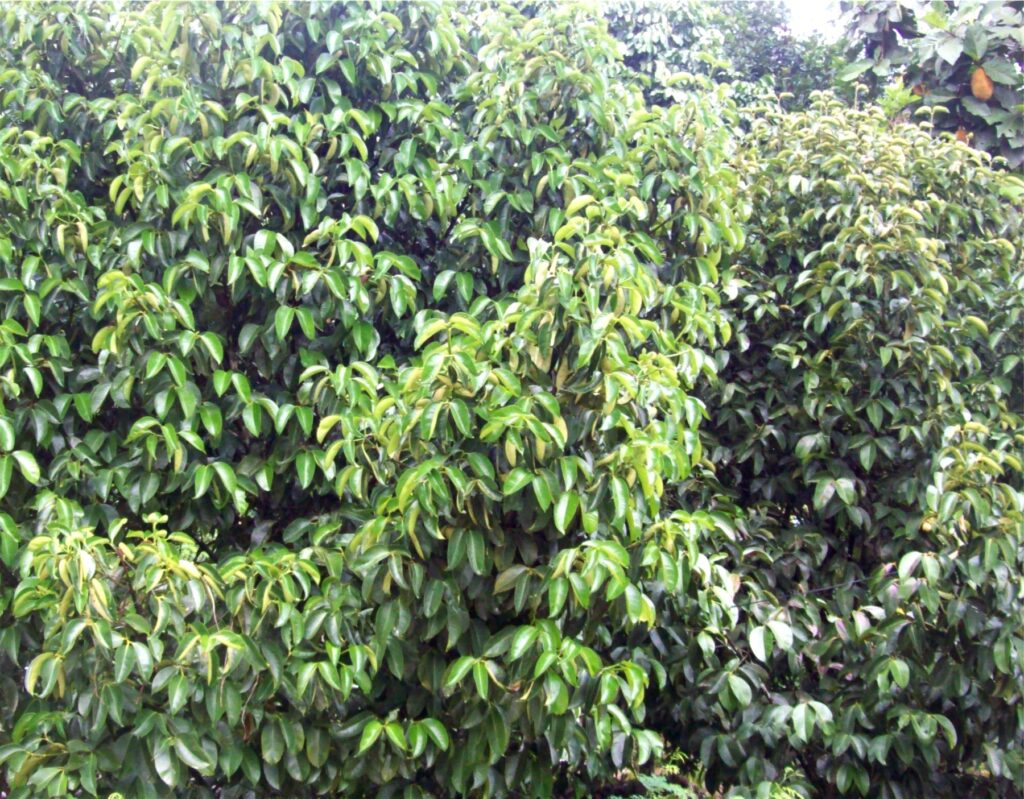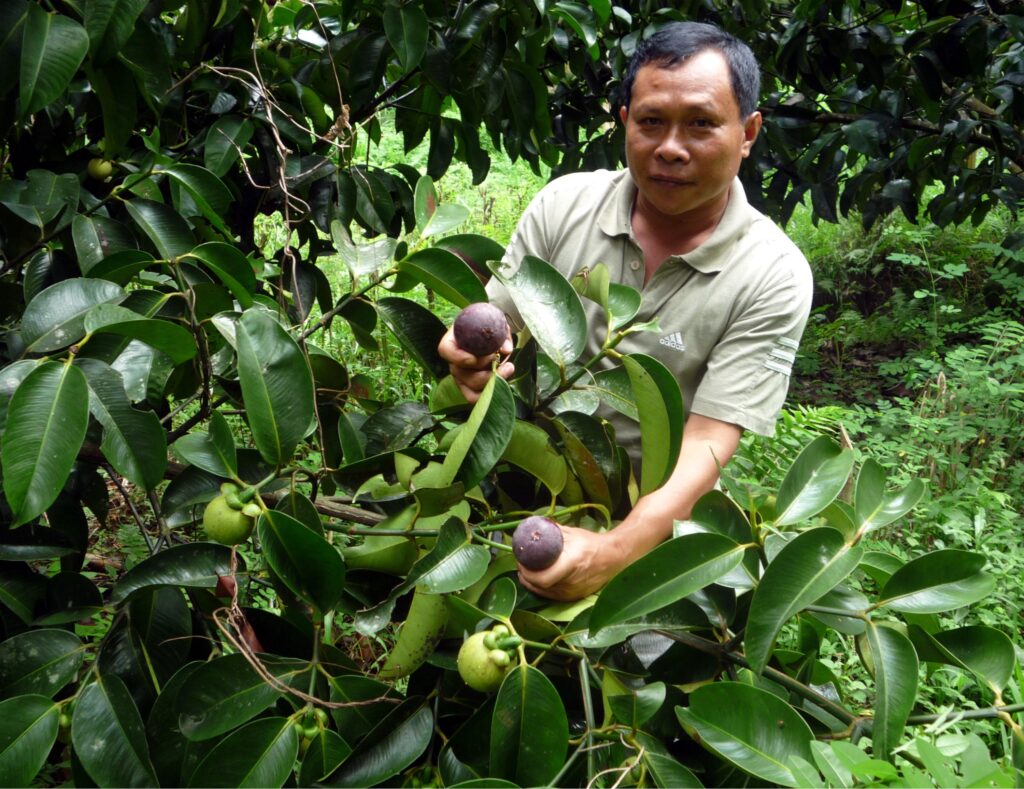Text and Photos by Henrylito D. Tacio
If durian is the “king of fruits,” then who is the queen?
Mangosteen, that’s who. This fruit is believed to have “cooling” effects that counteract the “intense heat” emitted by durian. The fact that the fruiting season of these two tropical fruits coincide makes their titles particularly apt.
Unlike other tropical fruits, nothing much has been written about mangosteen. But it is one of the most-sought after fruits. In fact, there was a legend about Queen Victoria offering a reward to anyone who could deliver to her the fabled fruit.
Hanging mangosteen fruits sold in Davao City.

In his publication, Hortus Veitchii, James Herbert Veitch reported that he visited Java (Indonesia) in 1892 “to eat the mangosteen. It is necessary to eat the fruit grown within three or four degrees of latitude of the equator to realize at all the attractive and curious properties of this fruit.”
British-born Malaysian author Desmond Tate has written these words in Tropical Fruit: “By popular acclaim, the mangosteen is held to be the most delectable of all the tropical fruits, and it has been proclaimed their queen. There is no doubt about the luxury of its taste. It has won unstinted praise down the ages from all who have encountered it.”
In an article which appeared in The New York Times, R. W. Apple Jr. hailed: “No other fruit, for me, is so thrillingly, intoxicatingly luscious, so evocative of the exotic East, with so precise a balance of acid and sugar, as a ripe mangosteen. I thought so when I first tasted one half a lifetime ago, in Singapore, and I’ve thought so ever since. I’d rather eat one than a hot fudge sundae, which for a big Ohio boy is saying a lot.”
Mangosteen is endemic to Sunda Islands and the Moluccas of Indonesia. However, it has been cultivated in Java, Sumatra, and in most parts of Southeast Asia since ancient times. In the Philippines, it is grown mostly in the southern part of the country (particularly Davao region).
In Bansalan, Davao del Sur, one of those who plant mangosteen in his farm is Benjamin Lao, a recipient of two awards from the Department of Agriculture. “Aside from durian and rambutan, I also plant mangosteen since it’s one of the most saleable fruits,” said Lao, whose farm is located in barangay Eman.
Mangosteen seedlings ready for planting.

Not far is the Mindanao Baptist Rural Life Center, a non-government organization based in barangay Kinuskusan, also of Bansalan, Davao del Sur. When it started its operation in the 1970s, it planted more than 500 mangosteen trees. Now, they are fully grown and bearing fruits.
“At the start of the fruiting season, we sell our mangosteen fruits at P60 per kilo,” says Roy Alimoane, the center’s director. “But as the fruiting starts to peak, the price goes down to as low as P30 per kilo.”
Although it is highly esteemed in Southeast Asia, mangosteen is not yet a major fruit crop. “In other tropical areas, this fruit is known only in botanical gardens and small experimental orchards,” noted Underexploited Tropical Plants with Promising Economic Value, published by the US National Academy of Sciences (NAS). “Curiously, it is unavailable in what could be its major markets: Central America, South America, Australia, and Africa, where it would be readily accepted if it could be economically produced.”
In the book, Manual of Tropical and Subtropical Fruits, author Wilson Popenoe quoted David Fairchild, a fruit explorer, describing the fruit in this manner: “This delicious fruit is about the size of a mandarin orange, round and slightly flattened at each end, with a smooth, thick rind, rich red-purple in color, with here and there a bright, hardened drop of the yellow juice which marks some injury to the rind when it was young.”
Mangosteen is usually eaten fresh as dessert. You need to hold the fruit with the stem-end downward. Take a sharp knife and cut around the middle completely through the rind, and lift off the top half. What you see are the fleshy segments exposed in the colorful “cup” – the bottom half of the rind. To eat it, lift out the segments by fork.
Fairchild wrote: “(Mangosteens) are strikingly handsome as anything of the kind could well be, but it is only when the fruit is opened that its real beauty is seen.”
And it is only when the fruit is eaten that makes it one of the most delicious of its kind. “The taste of the mangosteen pulp much resembles that of a well-ripened plum, only it is so delicate that it melts in the mouth like a bit of ice cream,” Fairchild noted. “There is nothing to mar the perfection of this fruit, unless it be that the juice from the rind forms an indelible stain on a white napkin.”
Mangosteen is known for its medicinal properties. The sliced and dried rind is powdered and administered to overcome dysentery. Made into an ointment, it is applied on eczema and other skin disorders. The rind decoction is taken to relieve diarrhea and cystitis. A portion of the rind is steeped in water overnight and the infusion given as a remedy for chronic diarrhea in adults and children.
Benjamin Lao, an integrated farmer from Eman, Bansalan, Davao del Sur.

In the United States, mangosteen juice is becoming a popular “health drink.” It is usually sold under the name “xango juice.” According to Dr. Brent A. Bauer, drinking mangosteen juice may help reduce arthritis inflammation and pain.
“A number of laboratory and animal studies suggest that mangosteen has significant anti-inflammatory effects,” wrote Dr. Bauer, a board certified in internal medicine, in the website of the Mayo Clinic. “And a few small-scale studies in humans indicate that the juice helps reduce blood levels of C-reactive protein (CRP). CRP is a substance associated with inflammation, which may be caused by widespread infection or disorders such as inflammatory bowel disease, lupus and rheumatoid arthritis.”
Dr. Bauer, however, cited some clarification. “The studies that found this reduction in CRP were not conducted with people who have arthritis,” he wrote. “And not everybody who has arthritis has elevated CRP. So at this point, while the data appears promising, it’s too early to say what role mangosteen juice has in treating arthritis symptoms.”
Despite its popularity, mangosteen is not grown in countries where it is well-regarded. Some have tried but failed. According to the NAS publication, the horticultural limitations are due to the following factors:
· Mangosteen seeds reproduce the characters only of the mother plant; there is no genetic variation produced. This makes the production of superior types difficult.
· Growers hesitate to plant mangosteen orchards because of the delay before their investments brings return; seedlings take as long as 15 years to produce a profitable crop.
· It is difficult to establish the plant in environments other than those identical to its natural habitat.
“To stimulate mangosteen production and make it commercially viable,” the NAS publication suggested, “considerable research should be directed toward solving its basic horticultural problems.”

